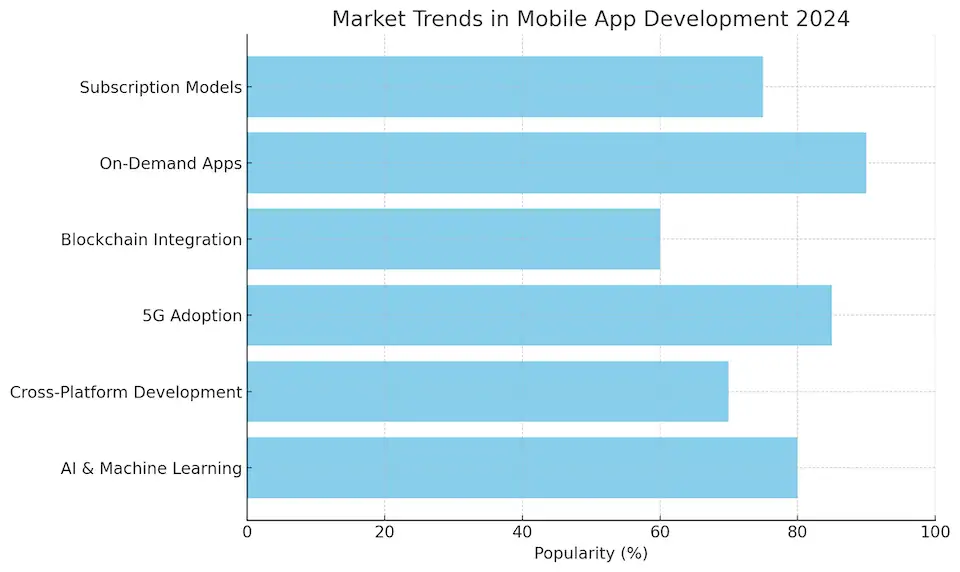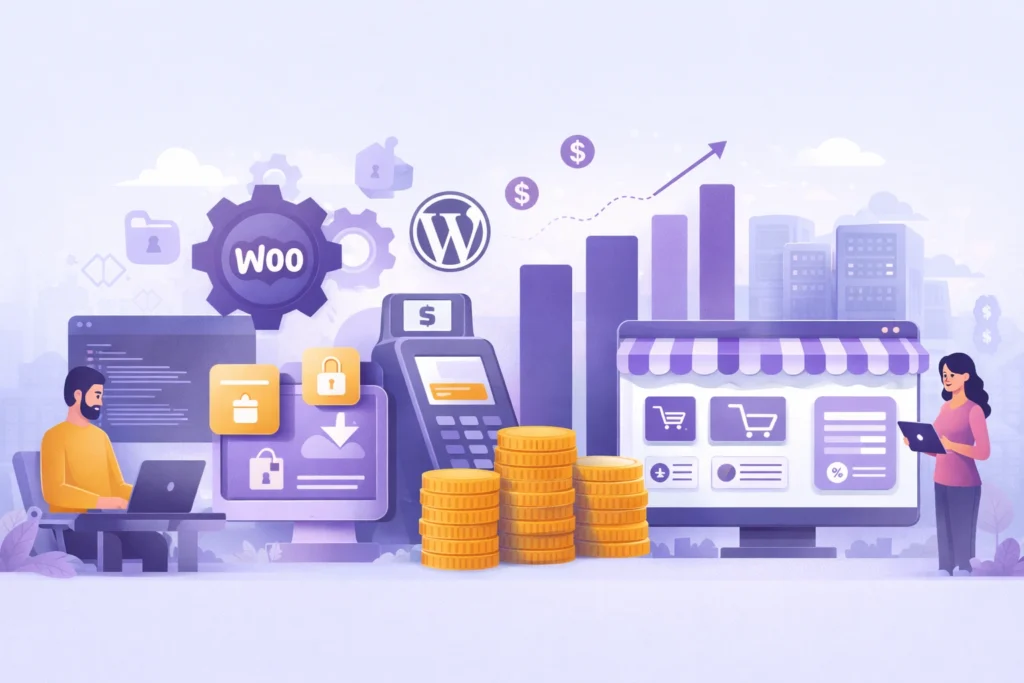In today’s digital-first world, mobile apps have become essential for businesses across all industries. Whether you’re a startup looking to scale or an enterprise aiming to provide better user experiences, Custom Mobile App Development are the way to go. But the burning question remains: How much does it really cost to build an app in 2025?
The truth is, there’s no one-size-fits-all answer. Development costs can vary significantly based on the complexity, platform, and even the development approach you choose. In this guide, we’ll break down all the factors that affect app development costs, so you’ll have a clear idea of what to expect before embarking on your mobile app journey.
This guide will walk you through a complete breakdown of mobile app development costs in 2025, covering everything from the development process, platform choice, and post-launch maintenance. Let’s dive in!
Market Trends for Mobile App Development in 2025
The mobile app industry is evolving rapidly, and several key trends are driving the demand for app development in 2025. Understanding these trends will help businesses align their development strategies to stay competitive.
- Rise of AI and Machine Learning: More apps are integrating AI-powered features such as personalized recommendations, chatbots, and advanced data analysis, offering highly personalized user experiences.
- Cross-Platform Development: With tools like Flutter and React Native gaining popularity, businesses are increasingly opting for cross-platform app development to save time and cost while targeting both iOS and Android users.
- 5G Adoption: The rollout of 5G networks is expected to enhance app performance, making mobile apps faster and more responsive, which is crucial for data-intensive apps like AR/VR and real-time gaming.
- Blockchain Integration: From cryptocurrency wallets to secure data sharing, blockchain is becoming a go-to solution for enhancing app security and transparency, especially in finance and healthcare apps.
- On-Demand Apps: The demand for on-demand services (e.g., food delivery, transportation) continues to grow, making this one of the most lucrative sectors for mobile app development.
- Subscription-Based Models: Many apps are moving away from one-time purchase models to subscription-based revenue streams, driving consistent income and fostering customer loyalty.
Learn More: How to Budget for Mobile App Development: A Complete Guide in 2024
Here’s a visual representation of key market trends shaping app development in 2024:

What Affects Mobile App Development Costs?
Before jumping into the numbers, it’s important to understand the key factors that influence the overall cost of mobile app development:
- App Complexity:
- Simple apps with basic functionalities such as a calculator or note-taking app cost less.
- Medium complexity apps with database integration, in-app purchases, or social media integration cost more.
- Highly complex apps, such as those using AI, real-time features, or blockchain, can be significantly more expensive.
- Platform:
- Cost of developing an Android app vs. iOS app development cost can vary slightly due to development environments, testing requirements, and platform-specific features. However, cross-platform tools may reduce overall costs.
- Design:
- Custom UI/UX designs tailored to provide a unique user experience are more expensive than using pre-built templates.
- Location of the Development Team:
- Hiring a development team in regions like North America or Western Europe tends to be more expensive than working with teams in Eastern Europe, India, or Southeast Asia.
Different Types of Mobile Apps
Mobile apps can be categorized based on their functionality, target audience, and development approach. Understanding the different types helps in making informed decisions about development strategies:
- Native Apps:
- Developed for a specific platform (iOS or Android) using platform-specific languages like Swift for iOS and Kotlin for Android.
- Pros: High performance, better user experience, full access to device features.
- Cons: Higher development cost, separate codebases for each platform.
- Cross-Platform Apps:
- Built using frameworks like Flutter or React Native, allowing a single codebase to be deployed across multiple platforms.
- Pros: Cost-effective, faster development time.
- Cons: Performance may not be as optimized as native apps, limited access to platform-specific features.
- Web Apps:
- Mobile-optimized websites that function like apps but are accessed through a web browser.
- Pros: No need for separate app stores, easy updates.
- Cons: Limited functionality compared to native apps, dependent on browser capabilities.
- Hybrid Apps:
- A blend of web and native apps, developed using HTML, CSS, and JavaScript but wrapped in a native shell.
- Pros: Easier to maintain, cross-platform compatibility.
- Cons: Performance lags compared to fully native apps.
- Progressive Web Apps (PWAs):
- Web apps that offer app-like experiences, including offline functionality and push notifications.
- Pros: No need for app store downloads, works on any device with a browser.
- Cons: Limited access to device hardware compared to native apps.

Steps to Develop a Mobile App in 2025
| Development Phase | Description | Time Estimate |
|---|---|---|
| Research & Planning | Market research, goal setting, budget allocation | 2 – 4 weeks |
| Wireframing & Prototyping | Visualizing app structure and testing UX | 2 – 4 weeks |
| UI/UX Design | Designing the user interface and experience | 3 – 6 weeks |
| Development | Front-end and back-end coding | 8 – 24 weeks (depending on complexity) |
| Testing & QA | Unit testing, bug fixes, and beta testing | 3 – 8 weeks |
| Deployment | App store submission and post-launch monitoring | 1 – 2 weeks |
Building a mobile app requires careful planning and execution. Here are the key steps involved in the development process:
- Research and Ideation:
- Identify your target audience and their needs.
- Research competitors and market demand.
- Define the app’s core features and functionalities.
- Wireframing and Prototyping:
- Create a wireframe that outlines the app’s structure and flow.
- Develop a clickable prototype to visualize the user experience and refine design choices.
- UI/UX Design:
- Focus on creating an intuitive and user-friendly interface.
- Ensure the design is responsive across different screen sizes and devices.
- Development:
- Choose between native development (iOS or Android) or cross-platform development (using tools like Flutter or React Native).
- Set up a backend system for data management and API integration.
- Ensure the app is scalable and secure.
- Testing:
- Conduct unit tests and integration tests to ensure all app functionalities work smoothly.
- Perform beta testing to gather real-user feedback.
- Deployment:
- Submit the app to the Google Play Store and Apple App Store.
- Ensure compliance with platform-specific guidelines.
- Post-Launch Maintenance:
- Regularly update the app to fix bugs, introduce new features, and optimize performance.
Benefits of Building a Mobile App
Mobile apps offer a wide range of benefits that can help businesses grow and provide better customer experiences:
- Increased Customer Engagement: With push notifications, personalized content, and real-time interactions, mobile apps keep users engaged, resulting in higher retention and increased lifetime value.
- Brand Recognition and Loyalty: A well-designed app can increase brand visibility and foster loyalty by offering users convenience, rewards programs, and personalized services.
- Revenue Generation: Apps with monetization models like in-app purchases, subscriptions, or ads can provide additional revenue streams, helping businesses capitalize on their customer base.
- Direct Marketing Channel: Apps provide a direct channel for communicating with customers. Whether it’s through push notifications, promotions, or updates, you can deliver timely messages that drive action.
- Improved Customer Insights: Mobile apps offer valuable data on user behavior, preferences, and interactions, enabling businesses to tailor their offerings and strategies based on insights.
Cost of Mobile App Development in 2025
The cost of developing a mobile app varies based on complexity, platforms, and location of the development team. Here’s a detailed table breaking down the cost of app development:
| App Type | Development Cost | Timeline | Platforms | Maintenance Cost (Annual) |
|---|---|---|---|---|
| Simple App | $20,000 – $50,000 | 2 – 4 months | Android, iOS | $3,000 – $10,000 |
| Medium Complexity App | $50,000 – $150,000 | 4 – 9 months | Android, iOS | $10,000 – $30,000 |
| Complex App | $150,000 – $500,000+ | 9 – 18 months | Android, iOS, Web | $30,000 – $100,000+ |
Note: These are average estimates and can vary based on the specific project requirements, features, and development team.
Mobile App Development Cost Breakdown
Now that we’ve covered the key factors, let’s look at the mobile app development costs breakdown:
1. Cost to Create an App in 2025
Here’s a general guide on the average cost of app development depending on app complexity:
- Simple App: $20,000 to $50,000
- Medium Complexity App: $50,000 to $150,000
- Complex App: $150,000 to $500,000+
2. Cost to Develop an Android App vs. iOS App
Developing an app for Android or iOS can affect the cost:
- Android App Development: On average, an Android app costs between $25,000 and $100,000, depending on complexity.
- iOS App Development: The cost to make an app for iPhone is similar to Android, averaging around $25,000 to $100,000, though iOS apps may require stricter design guidelines and app store requirements.
3. App Development Budget for Startups
For startups, managing the budget can be tricky. Startups typically aim to build an MVP (Minimum Viable Product) first to test the market. The budget for mobile app development in this case can range from $25,000 to $75,000. It’s essential for startups to consider custom app development pricing for features that make their app stand out from the competition.
Learn More: Mobile App Development from Scratch: The Ultimate Guide 2024
Common App Features and Their Costs
| Feature | Estimated Cost |
|---|---|
| User Authentication | $2,000 – $5,000 |
| Push Notifications | $3,000 – $7,000 |
| In-App Purchases | $4,000 – $10,000 |
| GPS Integration | $5,000 – $15,000 |
| Social Media Integration | $2,500 – $8,000 |
| Real-Time Chat | $6,000 – $15,000 |
| Payment Gateway Integration | $5,000 – $12,000 |
| Database Integration | $10,000 – $20,000 |
How Much Does It Cost to Hire an App Developer?
The cost to hire an app developer depends on the developer’s location and expertise:
- North America & Western Europe: $100 – $250 per hour
- Eastern Europe: $30 – $80 per hour
- India & Southeast Asia: $20 – $50 per hour
For a full development team (designers, developers, QA, project managers), costs can quickly add up, especially for medium to complex apps.
Want a seamless app development process?
See our step-by-step approach and transparent pricing.
Comparing Development Models
| Model | Pros | Cons |
|---|---|---|
| In-House Development | Full control, better team integration | Expensive, time-consuming |
| Outsourcing to an Agency | Access to experts, faster delivery | Potential lack of communication |
| Freelancers | Cost-effective, flexible | Less accountability, communication challenges |
| Cross-Platform Development | Build once, deploy on multiple platforms | Lower performance compared to native apps |
| Native Development | Optimized performance, better UX | Higher cost, longer development time |
Hidden Costs of App Development
In addition to initial development, there are other factors that can affect the total cost:
1. App Maintenance
Once the app is live, you’ll need to account for cost of maintaining a mobile app, which typically includes:
- Bug fixes and updates.
- Adding new features.
- Server hosting fees (if applicable).
App maintenance can cost around 15-20% of the initial development cost per year. For example, if your app costs $100,000 to develop, you can expect to spend around $15,000 to $20,000 annually on maintenance.
2. Third-Party Integrations
Many apps require third-party services like payment gateways, cloud storage, or analytics tools, which often come with monthly or annual fees.
3. App Store Fees
For Android, there’s a one-time fee of $25 to publish on the Google Play Store, while iOS has an annual fee of $99 for the Apple Developer Program.
App Development Cost Estimator
Mobile App Cost Calculator
Factors included in these tools are:
- Features and functionality.
- Number of platforms (iOS, Android, web).
- Backend requirements (e.g., APIs, databases).
- Design complexity.
Impact of App Monetization Models on Development Cost
- Freemium Model: Adds complexity with free and premium features, typically increasing development costs by 10-20%.
- Subscription Model: Requires robust back-end integration for managing payments and renewals, increasing initial costs but offering steady revenue.
- In-App Ads: Lower upfront cost but can negatively impact user experience if not implemented carefully.
- In-App Purchases: Adds additional coding and security layers, increasing development costs by 5-10%.
| Monetization Model | Impact on Development Costs | Pros | Cons |
|---|---|---|---|
| Freemium | Adds 10-20% more to development | Encourages user adoption | Complex to manage free vs premium features |
| Subscription | Requires subscription management | Steady revenue stream | Users may hesitate to pay recurring fees |
| In-App Purchases | Adds 5-10% to development costs | Profitable for apps with virtual goods | Requires additional coding & compliance |
| Ad-Based Revenue | Low upfront cost | Easier to implement | Can negatively affect user experience |
| Pay-per-Download | Minimal impact | Immediate revenue | May limit user base if priced too high |
Future-Proofing Your App
- Scalability: Ensure your app can handle increasing user loads by choosing scalable cloud infrastructure and modular development.
- Cross-Platform Compatibility: Build your app with future platforms and devices in mind, like wearables or AR/VR devices.
- Security Features: Incorporate robust security measures from the start, including data encryption, two-factor authentication, and regular security audits.
- Flexible Architecture: Adopt a microservices architecture to allow for easy updates and feature additions as technology evolves.

App Marketing and Launch Costs
- App Store Optimization (ASO): $500 – $5,000 to optimize the app’s description, screenshots, and keywords for app store visibility.
- Social Media Ads: Budget between $2,000 and $10,000 for pre-launch and post-launch advertising on platforms like Instagram, Facebook, and TikTok.
- Influencer Marketing: Costs can range from $1,000 to $20,000 depending on the influencers’ reach.
- PR and Press Releases: Expect to spend $2,000 – $8,000 for targeted press coverage and media outreach.
| Marketing Activity | Estimated Cost | Description |
|---|---|---|
| App Store Optimization (ASO) | $500 – $5,000 | Optimize app title, keywords, and screenshots |
| Social Media Ads | $2,000 – $10,000 | Pre-launch and post-launch ads on social platforms |
| Influencer Marketing | $1,000 – $20,000 | Partner with influencers for app promotion |
| Press Releases & PR Campaigns | $2,000 – $8,000 | Targeted media outreach and press release creation |
| Email Marketing | $500 – $3,000 | Email campaigns to promote app to existing users |
| App Review Sites | $300 – $2,000 | Submission to popular app review and download sites |
Local SEO Considerations
To target a local audience, optimize your app for local search:
- Geo-Targeted Keywords: Use location-specific keywords such as “food delivery app in New York” or “best fitness app in London” in your app description and promotional content.
- Local Listings: Ensure your app is featured on local app stores or directories specific to your region.
- Localized Content: Offer in-app content and notifications in local languages or with region-specific features to resonate with your target audience.
Industry-Specific App Costs
| Industry | Average App Cost | Key Features |
|---|---|---|
| Healthcare | $100,000 – $500,000 | Telemedicine, HIPAA compliance, patient records |
| E-commerce | $50,000 – $200,000 | Payment gateway, product catalog, user profiles |
| On-Demand Services | $60,000 – $250,000 | GPS tracking, payment integration, user reviews |
| Social Media | $80,000 – $300,000 | Real-time chat, photo sharing, notifications |
User Experience and Retention Strategies
- Personalization: Use AI and machine learning to offer personalized content, product recommendations, and user experiences.
- Gamification: Add elements like badges, rewards, or challenges to encourage user interaction.
- Regular Updates: Consistently roll out new features or improvements based on user feedback to keep your audience engaged.
- Push Notifications: Use timely and relevant notifications to re-engage users without being intrusive.
Revenue Model for Mobile Apps
There are several ways to monetize a mobile app. The revenue model you choose will depend on your app’s niche, target audience, and market trends:
- Freemium Model:
- The app is free to download but offers paid premium features.
- Example: Spotify, LinkedIn.
- Subscription-Based:
- Users pay a recurring fee (monthly or annually) to access the app or premium content.
- Example: Netflix, Apple Music.
- In-App Purchases:
- Users can purchase virtual goods or extra features within the app.
- Example: Gaming apps like Clash of Clans.
- Advertisements:
- Generate revenue by displaying ads within the app.
- Example: Free mobile games or news apps.
- Pay-Per-Download:
- Charge users a one-time fee to download the app.
- Example: Paid apps in the App Store and Google Play.
- Sponsorship and Partnerships:
- Partner with brands to promote their products/services in exchange for revenue.
By selecting the right revenue model and aligning it with your app’s user base, you can maximize profitability while maintaining a positive user experience.
Updated Statistics and References
- Statista reports that the global mobile app market is projected to generate over $935 billion in revenue by 2024, driven by subscription models, in-app purchases, and growing demand for mobile-first solutions.
- According to Sensor Tower, global app downloads reached 37.8 billion in Q1 2024, indicating continued growth in user adoption.
- App Annie states that average user spending on apps will increase by 25% in 2024, further boosting the importance of mobile apps for businesses across industries.
These statistics emphasize the importance of mobile app development and the potential ROI for businesses investing in this digital channel.
Challenges in Mobile App Development
Developing a mobile app in 2024 presents a range of challenges that businesses and developers need to be prepared for:
- Platform Fragmentation:
- The diversity of devices, screen sizes, and operating systems (Android vs. iOS) makes testing and optimization complex.
- Security Concerns:
- Ensuring the app is secure against data breaches, hacking attempts, and privacy issues is critical, especially for apps handling sensitive data.
- Scalability:
- As user bases grow, apps need to scale without sacrificing performance, which can be a significant challenge if not planned from the start.
- User Retention:
- Building an app is just the beginning—retaining users and preventing churn requires continuous updates, excellent UX, and engaging features.
- Compliance with App Store Guidelines:
- Both Google Play and Apple App Store have strict guidelines that must be followed, from app design to content policies. Non-compliance can result in rejection or removal from the store.
- Maintaining App Performance:
- High-performance apps are expected, especially in regions with access to 5G. Ensuring quick load times, minimal bugs, and seamless user interaction can be difficult as more features are added.
Possible Market Penetration Strategies for Mobile Apps
To successfully launch and gain traction in a competitive mobile app market, consider the following strategies:
- Freemium Strategy:
- Launch a basic version of the app for free, encouraging users to upgrade to a premium version for additional features. This model is ideal for encouraging wide user adoption initially.
- Social Media Marketing:
- Leverage platforms like Instagram, TikTok, and YouTube to promote your app. Using influencers and targeted ads can help boost visibility, especially among specific demographics.
- Referral Programs:
- Offer incentives for users to refer your app to others. For instance, give users discounts or premium features when they successfully bring in new users.
- App Store Optimization (ASO):
- Optimize your app’s title, keywords, and description in app stores to ensure better visibility. Positive reviews and regular updates also play a key role in ranking higher in app store searches.
- Partnerships and Collaborations:
- Partner with other apps, services, or platforms to expand your reach. For instance, a fitness app could partner with a health food brand for cross-promotional campaigns.
- Localized Marketing:
- Adapt your app for different regions by supporting local languages, currencies, and preferences. This is especially crucial if you’re targeting international markets.
Mistakes to Avoid When Developing a Mobile App
Avoiding common pitfalls can save time, money, and future headaches during mobile app development. Here are some mistakes to avoid:
- Neglecting Market Research:
- Failing to thoroughly research your target audience and competitors can lead to developing features that don’t resonate with users, making it difficult to stand out.
- Skipping Prototyping and Testing:
- Rushing into development without creating a proper prototype or conducting user testing can result in an app that doesn’t meet user expectations. Always test early and frequently.
- Overloading Features:
- Many businesses try to include too many features in the first version of the app. Focus on a Minimum Viable Product (MVP) that includes only the most essential features and build on it over time.
- Ignoring User Feedback:
- Not listening to user feedback after launch is a common mistake. Continual updates and improvements based on what users are asking for can lead to higher retention rates and app success.
- Underestimating the Cost of Maintenance:
- Many developers overlook the cost of maintaining a mobile app. Always plan for ongoing costs like server maintenance, bug fixes, and periodic updates.
- Poor Monetization Strategy:
- Choosing the wrong revenue model (e.g., relying too heavily on ads) can drive away users or limit potential profits. Analyze your user base and test different monetization strategies to find the best fit.
By avoiding these mistakes and focusing on effective strategies, your mobile app can have a better chance of achieving success in the competitive 2024 app market.How to Stay Within Your App Development Budget
Managing your app development budget is crucial for avoiding unexpected costs. Here are some tips:
- Start with an MVP: Focus on building core features first and consider launching a Minimum Viable Product (MVP). You can always add features later.
- Work with a Reputable Development Team: A trustworthy team can help you manage costs by advising on the most efficient solutions.
- Prioritize Features: Distinguish between must-have and nice-to-have features to avoid overspending.
Conclusion: What’s the Real Cost to Build an App in 2025?
In 2024, the cost of building a mobile app can vary widely based on complexity, features, and the development approach you choose. However, investing in a high-quality app can yield long-term benefits in terms of revenue, customer engagement, and brand visibility.
Whether you’re building a simple MVP or a complex, feature-rich platform, understanding the factors that influence development costs is essential for making informed decisions. At Miracuves Solutions, we specialize in helping businesses of all sizes develop mobile apps that are scalable, secure, and designed to succeed in today’s competitive market.
Ready to bring your app idea to life? Contact us today for a free consultation and cost estimate for your next mobile app project. Let’s build something amazing together!
Curious about your app’s cost?
Our experts will define scope, estimate expenses, and optimize your budget.
FAQs
1. How Much Does It Cost to Build an App in 2025?
The cost to build an app in 2025 ranges from $20,000 to $500,000 or more, depending on the complexity, features, platforms, and the development team’s location. Simple apps may cost as little as $20,000, while complex apps with advanced features like AI, real-time updates, and high-end security can easily exceed $500,000.
2. What Factors Influence Mobile App Development Costs?
Several factors influence the cost of mobile app development, including:
App complexity (basic, medium, complex)
Platform (iOS, Android, or both)
Design requirements (custom UI/UX)
Features (real-time chat, payment gateways, GPS)
Developer location (North America, Europe, Asia) These variables can drastically impact the overall budget for creating an app.
3. What Are the Most Common Features in Mobile Apps and Their Costs?
Some of the most common app features and their estimated development costs include:
User Authentication: $2,000 – $5,000
Push Notifications: $3,000 – $7,000
In-App Purchases: $4,000 – $10,000
Real-Time Chat: $6,000 – $15,000
Payment Gateway Integration: $5,000 – $12,000 Adding these features will affect your app development costs based on their complexity and implementation.
4. What Are the Best Ways to Monetize a Mobile App?
The best app monetization strategies include:
Freemium Model: Offering a free version with premium features behind a paywall.
Subscription Model: Charging users a monthly or annual fee for access.
In-App Purchases: Allowing users to buy virtual goods or additional content.
Ad-Based Revenue: Generating income by showing ads within the app. Each monetization method impacts the app’s design and development costs differently.
5. How Much Does It Cost to Maintain a Mobile App?
The cost of maintaining a mobile app typically ranges from 15% to 20% of the initial development cost per year. This includes updates, bug fixes, server hosting, and new feature implementation. For instance, if your app cost $100,000 to develop, expect to spend around $15,000 to $20,000 annually on maintenance.
6. Which Is Better: Native or Cross-Platform App Development?
Both approaches have their pros and cons:
Native App Development offers better performance and UX but is more expensive as it requires separate development for iOS and Android.
Cross-Platform Development (using frameworks like Flutter or React Native) is more cost-effective and faster to deploy, but performance might not be as optimized as native apps. The choice depends on your app’s goals, budget, and target audience.
Related Articles:









